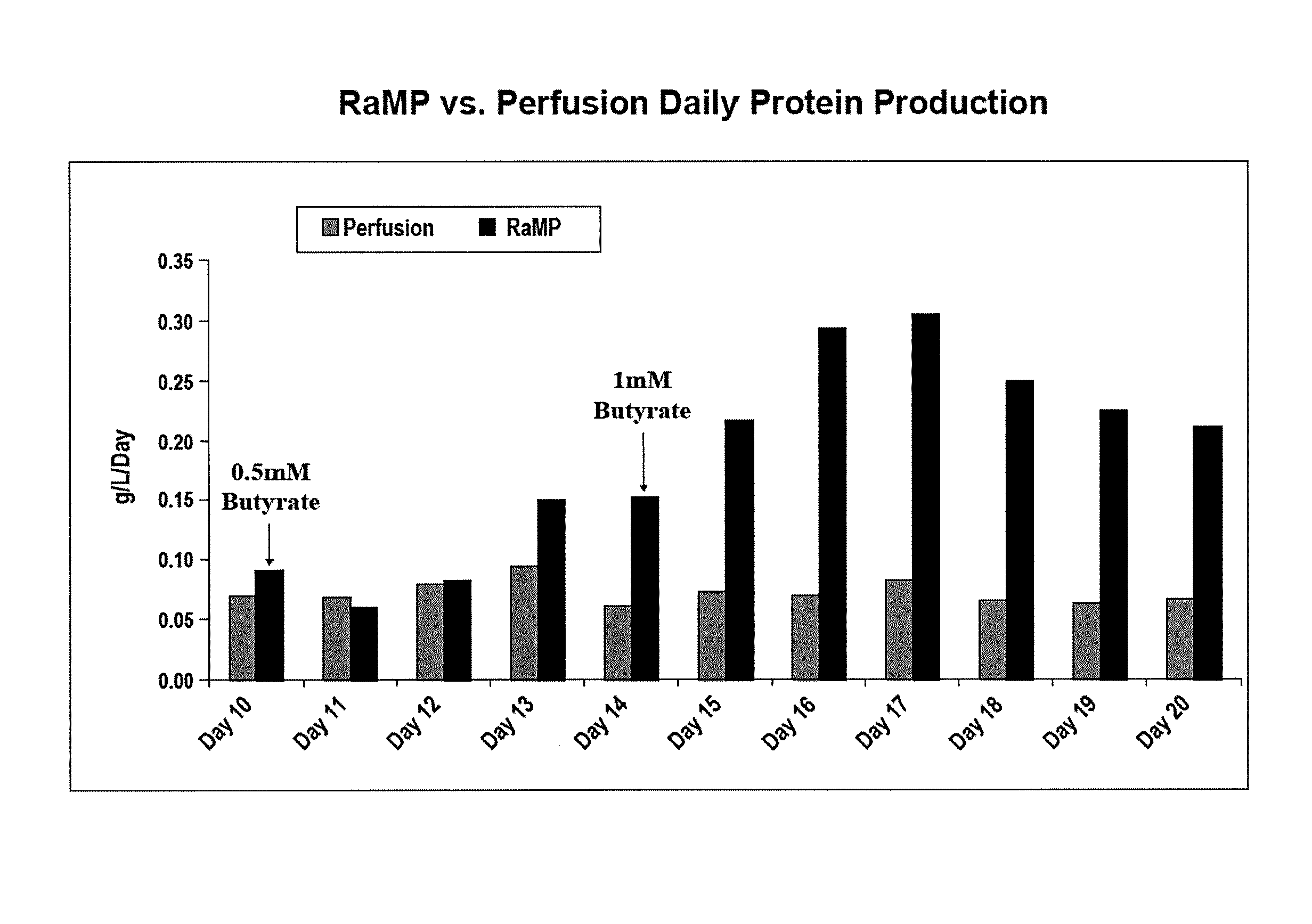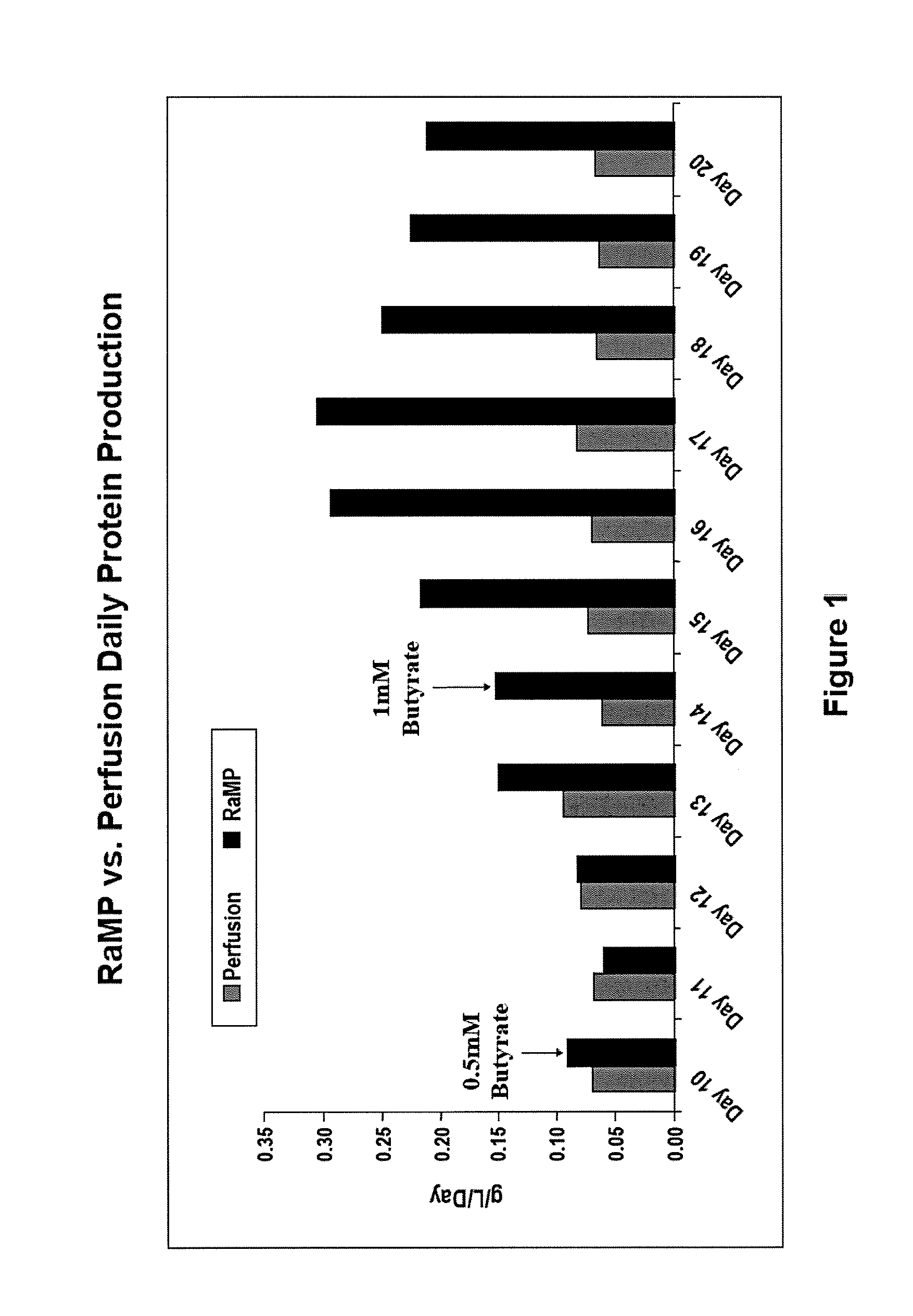Intensified Perfusion Production Method
a perfusion cell culture and production method technology, applied in the field of cell culture, can solve the problems of reducing efficiency and overall productivity, reducing cell viability over time, and limitations of these methods, and achieve the effect of high cell density and high cell viability
- Summary
- Abstract
- Description
- Claims
- Application Information
AI Technical Summary
Benefits of technology
Problems solved by technology
Method used
Image
Examples
example 1
General Materials And Methods
[0079]The production cell line used for all experiments is a CHO (Chinese Hamster Ovary) cell-derived cell line transfected with the desired construct to produce a recombinant IgG1 protein. For all of the experiments, the cell line was grown in the RBM12.1 media under selective pressure (100 μg / ml Hygromycin B and 500 nM methotrexate). The cells were seeded in at a density of 4×105 to 1×106 cells per milliliter, depending on bioreactor size. pH was kept at 7.1±0.05 and temperature was kept at 37° C.±0.5. The perfusion rate for both traditional perfusion and the methods of the invention (RaMP) was 1.0 to 2.0 volumes / day. The cell retention devices used were the hollow fiber system and / or the cell settler system. Because of the high density of cells achieved utilizing RaMP (upwards of 40 to 60 million cells / ml), the hollow fiber system proved to be problematic due to clogging of the fibers. The cell settler system (retention by gravity) seem to overcome th...
example 2
Comparison of Cell Viability Using Traditional Perfusion And RaMP Methods
[0080]The mammalian host cell line used is a Chinese hamster ovary (CHO) cell line. This cell line has been transfected with the light and heavy chains of a chimeric IgG1 monoclonal antibody. The cells were grown in RBM12.1 medium under selective pressure (100 μg / ml Hygromycin B and 500 nM methotrexate (MTX). The medium used for this example contained the components in Table 1. Additional factors such as 10 μg / ml recombinant human insulin and 0.1% F68 are also added to the medium.
[0081]While a variety of commonly used cell culture or production media may be used in the practice of this invention, presently preferred embodiments use serum-free cell culture media formulated for recombinant protein production. Such media may be found in co-owned Application 60 / 838,865, which is herein incorporated by reference in its entirety.
[0082]During the growth period, the cultures were controlled at pH 7.1±0.05 by the use of...
example 3
Effects of Sodium Butyrate Addition On Cell Viability
[0085]In order to investigate if the method used to deliver sodium butyrate into the cell culture bioreactor would effect cell viability, two modes of delivery were tested: bolus introduction of the desired sodium butyrate concentration and the gradual “ramping” to the desired sodium butyrate concentration. The growth period conditions were identical to those described above.
[0086]On Day 9, sodium butyrate was introduced into the bioreactors. In the bolus condition, 2 mM sodium butyrate (final concentration) was added to the medium and perfused into the bioreactor. In the RaMP condition, sodium butyrate was introduced starting at 0.5 mM (final concentration) and gradually increased to the maximal concentration by Day 14. The maximal concentration of sodium butyrate was maintained for the rest of the production run. Cell viability was determined by pulling samples from each bioreactor and trypan blue staining for live / dead cells. A...
PUM
| Property | Measurement | Unit |
|---|---|---|
| Temperature | aaaaa | aaaaa |
| Temperature | aaaaa | aaaaa |
| Temperature | aaaaa | aaaaa |
Abstract
Description
Claims
Application Information
 Login to View More
Login to View More - R&D
- Intellectual Property
- Life Sciences
- Materials
- Tech Scout
- Unparalleled Data Quality
- Higher Quality Content
- 60% Fewer Hallucinations
Browse by: Latest US Patents, China's latest patents, Technical Efficacy Thesaurus, Application Domain, Technology Topic, Popular Technical Reports.
© 2025 PatSnap. All rights reserved.Legal|Privacy policy|Modern Slavery Act Transparency Statement|Sitemap|About US| Contact US: help@patsnap.com


